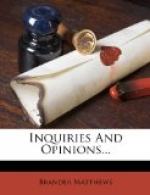It deserves to be noted also that when Colonel Esmond broke his sword before the unworthy prince whom he had served so long and so loyally, he was only following an example which had been set by the noble Athos, who had snapt his weapon asunder before Louis XIV because that inhuman monarch had taken for himself Mlle. de la Valliere, the young lady beloved by the Vicomte de Bragelonne, the son of Athos. And the same effect is to be found also in the opera of ‘La Favorite.’ The book of Donizetti’s opera bears the names of Alphonse Royer and Gustave Vaez; but it is said to have been revised by Scribe. It was derived from a forgotten play called the ‘Comte de Comminges,’ written by one Baculard-D’Arnaud, and this in turn had been taken from a novel written by the notorious Mme. de Tencin, the callous mother of D’Alembert. The scene of the sword-breaking is not in the novel or the play; and quite possibly it may have been introduced into the book of the opera by the fertile and ingenious Scribe. ‘La Favorite’ was produced in 1840, when Thackeray was in Paris preparing the ‘Paris Sketch Book.’ It was in 1850 that Dumas published the ‘Vicomte de Bragelonne’; and it was in 1852 that Thackeray put forth ‘Henry Esmond.’ But it was back in 1829 that the commandant Hulot in Balzac’s ‘Chouans’ had broken his sword across his knee rather than carry out an order that seemed to him unworthy. This is not quite the same effect that we find in ‘La Favorite’; but none the less Scribe may have been indebted to Balzac for the suggestion.
There is no denying that the striking situation which Thackeray used with so much skill in his novel had already been utilized in the stirring romance of Durras and in the pathetic libretto of Royer, Vaez, and Scribe. Did Thackeray borrow it from the romance or from the libretto? Or did he reinvent it for himself, forgetting that it had already served? He was in Paris when Donizetti’s tuneful music was first heard; and he was going to the opera as often as he could. He was fond of Dumas’s interminable tales of adventure; and he had a special liking for Athos. It is in one of the ’Roundabout Papers’—’On a Peal of Bells’—that he declared his preference. “Of your heroic heroes, I think our friend, Monseigneur Athos, Comte de la Fere, is my favorite.” Is this a case of conveyance, such as is often carelessly called plagiarism? or is it a case of unconscious reminiscence? That Dumas knew what he was doing when he lifted the situation out of ‘La Favorite’ is very likely, for it was not his custom to be overscrupulous in taking what he could make his own. But Thackeray had been careful to credit the suggestion of one or two of his earlier French sketches to the Parisian story-tellers he had put under contribution. Besides he was a man of transparent honesty; and it is therefore highly probable that he had no consciousness that the scene was not original with him.




